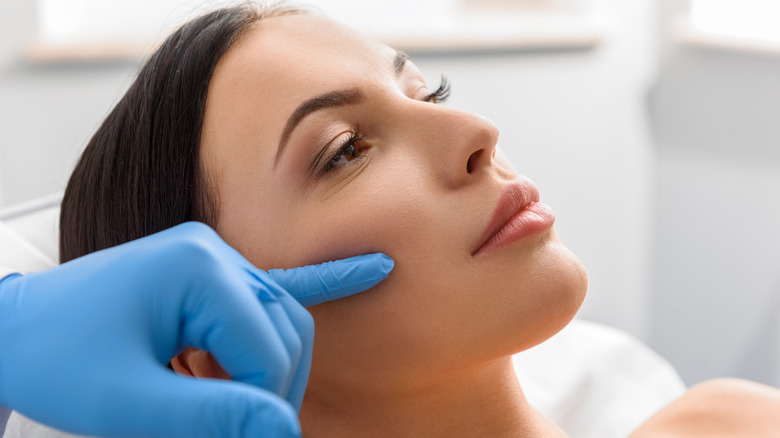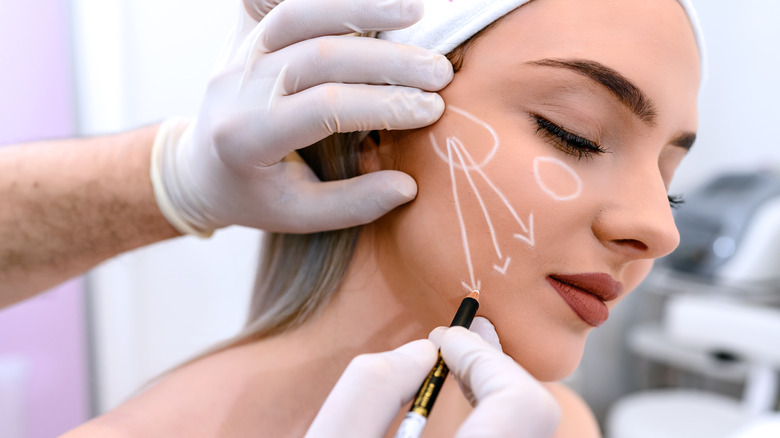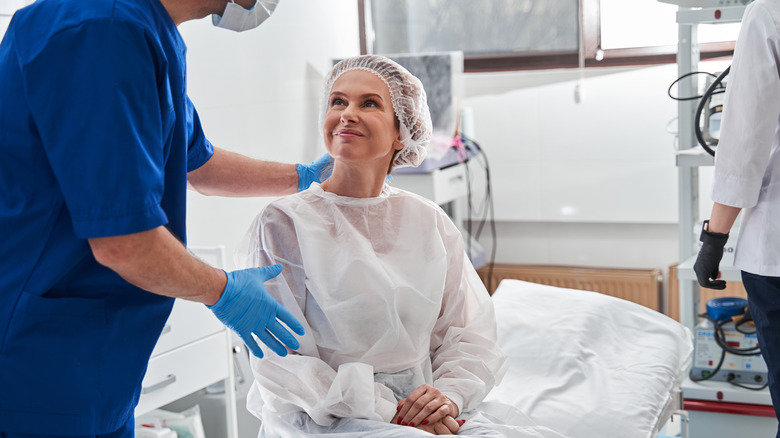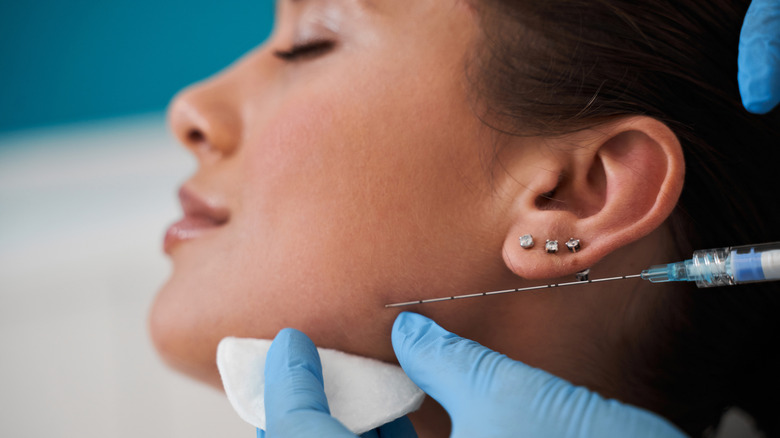Cheek Implants Are The Plastic Surgery Fad Coming For Buccal Fat Removals
Over the last few years, a quiet movement toward a sharper, more chiseled face started forming until finally, in 2022, the cat was out of the bag: Buccal fat removal surgery was the reason so many influencers suddenly seemed to have cheeks so hollow, no contour could possibly compete. By the end of the year, online searches for the procedure shot up, according to Google Trends, and spectators buzzed about which celebrities they believed had done it, such as Lea Michele and Megan Fox.
But like many other cosmetic surgery fads — such as the busty chests of the early aughts or the wave of exaggerated BBLs throughout the last decade — the buccal fat removal trend doesn't seem to have long-term staying power among the general population. In fact, 2022 data from the American Society of Plastic Surgeons revealed a high demand for cheek implants, while buccal fat removal failed to land in the list of the most popular procedures.
So what exactly are cheek implants, and why do so many people request them at the surgeon's office? Here's what to know about buccal fat removal's top competition.
What are cheek implants?
You're probably already familiar with breast implants and buttock implants, and cheek implants follow a similar concept. Essentially, cheek implants are implants inserted into the cheeks to alter the look and firmness of the face. According to Johns Hopkins Medicine, the implants are generally made of medical-grade silicon and, depending on their placement, offer a different facial shape. Malar implants are inserted right on the cheekbones for a defined, lifted effect, while submalar implants are inserted lower into the cheeks to create a fuller, rounder look. Combined cheek implants involve both types in a single procedure.
To ensure you look natural — and to keep the implants from going astray in your face — surgeons typically secure the material in the cheek precisely where you want it. "If not secured into place, cheek implants can shift in the face, resulting in the implant moving to an undesired location [and even] facial deformity," Dr. Catherine Chang, an L.A.-based board-certified plastic surgeon, explained to Allure.
Why get them?
Cheek implants may or may not have been on your radar until recently, but they could be one solution to a cosmetic complaint you or someone you know has. Friendly reminder: No one needs cheek implants — or any other elective cosmetic surgery, for that matter. However, cheek implants could give you a boost if you believe your face is too slim or gaunt. So yep, the sunken-in look made popular by the buccal fat removal trend isn't everyone's cup of tea, and some people with natural cheek dips might prefer the fullness of implants instead.
Cheek implants may also be treated as an anti-aging step for those who aren't satisfied with how their face has changed over time. Facial volume loss is common as people get older, notes Specialty Aesthetic Surgery, a cosmetic surgery center in New York City. Therefore, cheeks that were once plump and lifted may begin to sag and wrinkle. Implants may restore a fuller, youthful face shape.
That doesn't mean you won't find people in their twenties and thirties getting cheek implants. The surgery may be useful for those who have flat cheeks but desire more dimension, for example. It's sometimes even recommended as a treatment for under-eye bags, as per Gallo MD. Put simply, the motives for getting cheek implants can be highly personal and variable depending on the person.
The procedure
The potential effects of getting cheek implants might sound promising, and perhaps you've seen some impressive before-and-after photos online. But remember that similar results require going under the knife. Expect anesthesia with this kind of procedure, according to the American Society of Plastic Surgeons. Your doctor will determine if intravenous sedation (where you remain conscious, though drowsy) or general anesthesia is right for you.
Once you're relaxed and comfortable with anesthesia, the surgery begins, often with a cut inside the mouth to reach the cheek area. "We make an incision above the teeth and the sulcus — way up in the gum," Dr. Theda Kontis, a double-board certified facial plastic and reconstructive surgeon and otolaryngologist, and the president of the American Academy of Facial Plastic and Reconstructive Surgery, shared with Allure. "Then we use instruments to lift tissue off of the bone to basically make a pocket for the implant."
In some cases, cheek implants require an incision in the lower eyelid or hairline rather than the mouth. These alternate spots are more common if the surgery coincides with another facial procedure. Regardless of where your surgical site is, the process will end with suturing the incision and bandaging or taping the face to begin the healing process.
Recovery
Lifted cheekbones and a fuller facial profile won't be obvious right after a cheek implant surgery is performed. You'll likely experience some swelling for at least a week or two, with the most noticeable swelling occurring in the first 72 hours post-op, per Stanford Medicine. Often, it can take at least three months for swelling to completely subside, and you may not reach your final result until the six-month mark.
You might be asked to keep bandages on the face for some time following the procedure to protect any wounds and stabilize the implant until the cheeks have had time to heal. You'll likely also have to alter your diet until your mouth and cheeks have had a chance to recover — don't be surprised if your surgeon instructs you to follow a liquids-only diet for the first week.
Finally, pain is to be expected, as is the case with most surgeries. The skin may also feel as if it's being pulled or stretched for the first few days to accommodate the new implants, which can be uncomfortable for some people. To cope with post-surgery pain, your doctor may prescribe medication or suggest over-the-counter remedies for mild discomfort.
Risks
Even if plastic surgery fads make cosmetic surgeries seem like no big deal, it's important to remember that they're still invasive medical procedures that come with risks. The American Society of Plastic Surgeons lists several potential complications of facial implants, including bleeding, scarring, skin damage or discoloration, and infection.
Anesthesia carries its own set of risks. Cognitive dysfunction, breathing problems, and even death are some issues associated with anesthesia, though the American Society of Anesthesiologists notes that they're rare.
Another risk of getting cheek implants, particularly for cosmetic reasons: You might not be satisfied with the final result. Your implants may end up looking too big for your face, or they might create a shape you later decide doesn't really suit you. That might be why 65% of respondents in a survey by Medical Accident Group admitted that they regretted getting surgical cosmetic work done. Ideally, a well-trained plastic surgeon will thoroughly discuss your needs and expectations to minimize the risk of second-guessing your decision later.
Can cheek implants and buccal fat removal ever work together?
Cheek implants appear to be the antithesis of the buccal fat removal craze — one adds shape and fullness to the face, while the other excises natural pads of fat for a slim and sculpted effect. However, you don't necessarily have to choose one or the other. It's possible to have both procedures at once, if that's your thing.
So how can the two seemingly opposing procedures work together? Essentially, cheek implants can make the look of buccal fat removal more prominent while enhancing bone structure. Gotham Plastic Surgery explains that malar cheek implants can be inserted high in the cheeks to "build up" the cheekbones and counterbalance the hollow look caused by buccal fat removal. Alex Montague, a double-board certified plastic surgeon at the Quatela Center for Plastic Surgery, also told Insider that cheek implants often help define the jawline in patients extracting buccal fat.
Keep in mind that cheek reduction procedures are permanent, and you can't simply insert more implants to reverse buccal fat removal (via The Washington Post). If you get implants and fat removal simultaneously and later decide that you aren't happy with your appearance, you might need to turn to another procedure, such as injections or fat grafting, to get the desired effect.
Alternatives to cheek implants
Implants aren't the only way to change the shape of your face. One common alternative is getting injectable fillers to create a gel cushion in the cheeks. Fillers don't require surgery, but the results aren't long-lasting the way facial implants are, as cosmetic surgery clinic The Lucas Center points out. Rather than a (typically) one-and-done operation, you'll have to visit your doctor's office at least once every two years to maintain your desired face shape.
Fat grafting is another option for upping the volume in the cheeks. While it's not as invasive as cheek implant surgery, it's still a somewhat complicated technique with multiple steps. Generally, fat is taken from a fleshy part of the body, such as the thighs, via liposuction. Then, the fat is injected into the cheek tissue based on the shape and level of fullness you prefer.
If needles and liposuction wands make you squeamish, tweaking your makeup could be enough to alter the look of your cheeks. For a fuller face shape, try TikTok's latest blush hack that makes cheeks appear perfectly plump and dewy. To accentuate cheekbones, apply highlighter or light contour to the tops of your cheekbones, followed by a darker shade just below, to turn flat cheeks 3D.
Should you get cheek implants?
Cheek implants may be one of the most popular cosmetic surgeries of the moment, especially among the 45-and-under crowd, as per the 2022 data from the American Society of Plastic Surgeons, but does that mean you should consider the procedure too? Before you run to your local plastic surgeon's office, keep in mind that beauty trends come and go (buccal fat removal being one prime example), yet the consequences of going under the knife can be permanent. Therefore, it's wise to carefully think over cheek implants before making the commitment.
One way of test-driving a different face shape is to try fillers first. Note, however, that you can't go straight from fillers to implants. "If you already have lots of filler in there, you need to [get back to] baseline to start," Dr. Theda Kontis explained to Allure. "You don't want to put an implant in, wait for all the filler to go away, and then see what you've got."
Even if you decide that you prefer a more plump and padded cheek, that doesn't necessarily mean implants are right for you. While only anecdotal, 57% of reviewers on RealSelf who received cheek implants felt the procedure was worth it, while 43% didn't believe it was worth it. Ultimately, any medical procedure, especially when elective, is a highly personal choice, and it's up to you and your doctor to decide if you're a good candidate for cheek implants.








